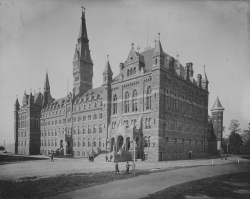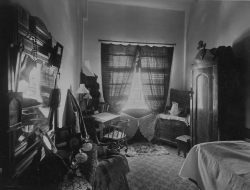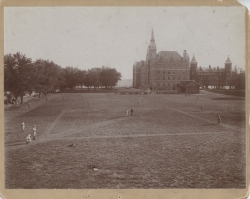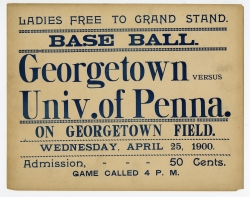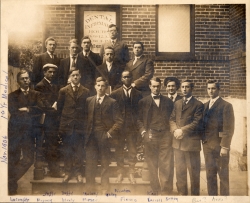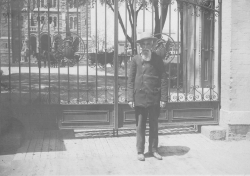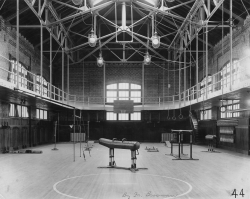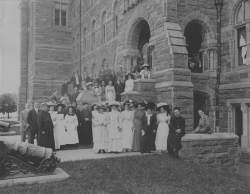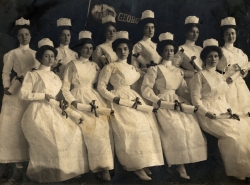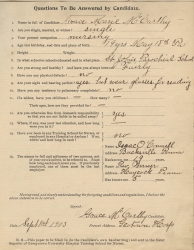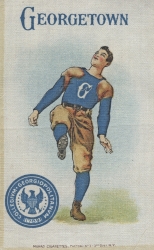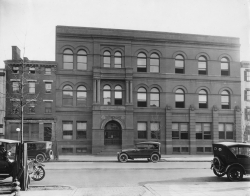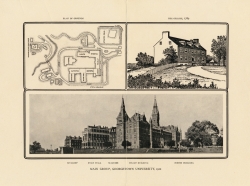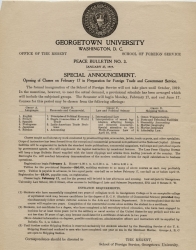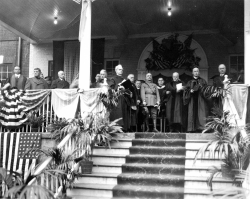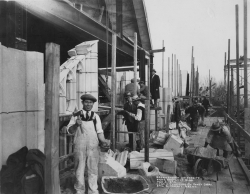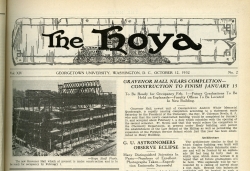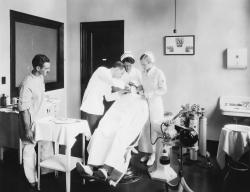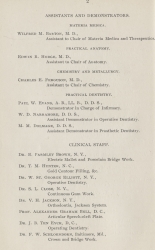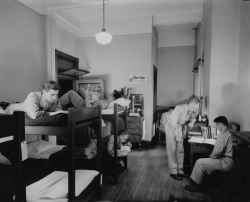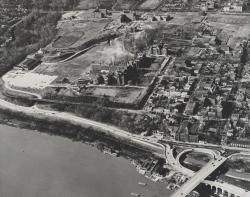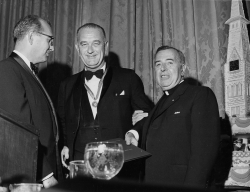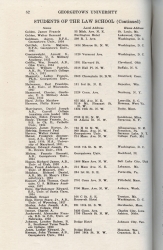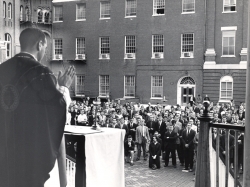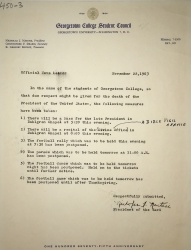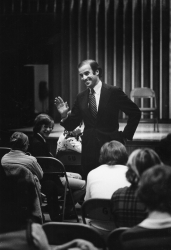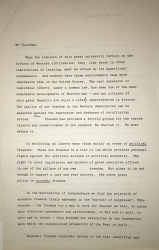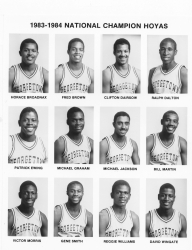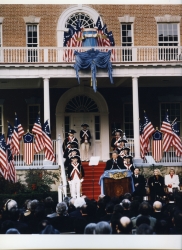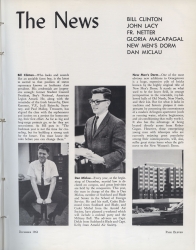In 1900, Georgetown University was a school with 554 students who were enrolled in the College of Arts and Sciences or the Graduate, Medical or Law Schools and who were taught by a faculty of around 110. Main campus consisted of five academic buildings clustered around the Quadrangle, as well as the Observatory and Dahlgren Chapel, with the Law and Medical Schools housed off-campus. And the curriculum was very narrow, with no majors or no electives.
By the end of the century, the University had greatly expanded. In 1999, enrollment stood at 12,427 and the faculty numbered around 1224. New schools were added (and in some cases later subtracted), with the Dental School opening in 1901, the Training School for Nursing in 1903, the School of Foreign Service in 1919, the Institute of Languages and Linguistics in 1949, the School of Business Administration in 1957 and the School of Continuing Studies in 1974. Physical plant grew to include 43 more buildings, both on and off campus, to accommodate the larger student body and expanded curriculum.
The images used in this exhibition, taken from the extensive photographic collections held in the University Archives, offer a glimpse into the development and expansion of Georgetown University in the 20th century. Select images are accompanied by complementary items, also from collections in the University Archives.
This exhibition is a reworking of the Georgetown in the 20th Century exhibition which was on display on the 5th floor of Lauinger Library from August 13, 2012 to June 16, 2014.
Student room in Healy Hall, 1901
For the 1901-1902 academic year, students paid $400 for tuition, board and lodging in a shared dormitory room, as well as for washing and mending. Private rooms such as this were available for an additional charge of $80.
Baseball game on the Georgetown College Field, ca. 1900 (photograph by C.M. Bell, 463 & 465 Pennsylvania Ave., Washington, D.C.). Poster from April 25, 1900 baseball game
Gatekeeper James McNerhany, before 1910
A handwritten note on the back of this photograph reads: Mr. Mac - James McNerhany, who had been for many years the faithful watchman and gatekeeper of G.T. College. He had been a confederate soldier. Died at the G.U. Hospital, May 27, 1910.
Interior of Ryan Gym, 1910 (photograph by John Brosnan, S.J.)
Ryan Gym, a gift of Ida M. Ryan of New York, opened in October 1906 and was designed to serve a student body of around 250. Note the elevated running track around its perimeter. A Hoya article of January 10, 1940, reports the track’s removal and notes: This structure had long been a hindrance to basketball players . . . as students know, it was impossible to make a shot from the corner of the court as the ball was blocked by the overhanging balcony. Ryan Gym was replaced by McDonough Arena and is now incorporated into the Davis Performing Arts Center.
Visitors from the Visitation Academy and Georgetown students on the steps of Healy Hall, 1911
n 1799, a formal religious community according to the Visitandine rule and a school for girls were founded near what are now 35th & P Streets, NW. The school became known as The Young Ladies’ Academy of the Visitation at Georgetown. Given the school’s geographical proximity to Georgetown University, it was natural that associations would form between the two institutions. By the 1850's, for example, students at the University were hosting dances that included young ladies from their own families and from Visitation. Ties grew stronger after a junior college was established at Visitation in 1919.
School of Nursing Class of 1912 (photograph by Scherer Studio, 1207 F St., NW, Washington, D.C.). List of Lay Nurses, 1903-1908, open to the application by Grace Marie McCarthy for admission to the Georgetown University Hospital Training School for Nurses
Women have studied at Georgetown continuously since the founding of the Nursing School in 1903. The School was established to provide support for the University Hospital which opened in 1898. The Hospital was managed by the Sisters of St. Francis but as the facility expanded the Order was not able to supply enough Sisters to staff it. The University, therefore, created a training school for nurses run by the Order. Students were initially required to live at the Hospital as there were no other women students at the University and, as a consequence, no women’s dorm.
Nursing education began as a three year diploma program. In 1944, a five year program was introduced with two academic and three clinical years. The same year, the Georgetown University Training School for Nurses officially became the Georgetown University School of Nursing. In 1951, the five year program gave way to an integrated four year degree.
The List of Lay Nurses, 1903-19808, was discovered in a credenza in the School of Nursing and Health Studies in 2009. It was brought to the attention of Bill Cessato, Director of Communications for the School, who facilitated its transfer to the University Archives so that it could be permanently available for research use.
Dramatic Association, 1913. Pictured in the center of the last row is Edmund A. Walsh, S.J.
Plays have been put on by Georgetown students since the 1790s and a dramatic troupe was officially established on campus in 1853. In 1910, after a period of obscurity, the Dramatic Association was reorganized by Edmund A. Walsh, S.J., for whom the School of Foreign Service is named. The first production put on by the revitalized group was All the Comforts of Home, a farce by William Gillette. The show was so well received that Fr. Walsh, working with the Alumni Association, arranged for it to be performed in the Astor Room of the Waldorf Astoria Hotel in New York.
The Association adopted a new name in 1919 – the Mask and Bauble Club. The name was chosen to reflect that the Club would perform both tragedies and comedies.
Football game against the University of Virginia on the Georgetown College Field, 1914 (photograph by Seabrook Bros., 906 F Street, Washington, D.C.). Georgetown football-themed Murad tobacco silk, ca. 1906 (Gift of Eric Wind, F’2009)
The University of Virginia was the opponent in Georgetown’s first intercollegiate football game held in the fall of 1889. The Hoyas defeated the visiting Cavaliers, 34-0, beginning a spirited rivalry. The annual Georgetown-Virginia game became the highlight of the football season, attracting as many as 5,000 spectators to campus.
Football was a very different game at this time. According to newspaper accounts, several games in the 1890s were played in near riot conditions. In the October 23, 1915, Georgetown game against Army at West Point, circumstances required the referee to issue a ruling that biting, while not explicitly prohibited by the rules, did constitute unnecessary roughness.
American tobacco companies began including fabric swatches in their packaging as promotional items between 1906 and 1910. Although these swatches were most commonly satin, they came to be known as tobacco or cigarette “silks.” Companies encouraged women to fashion them into household items such as quilts or pillows—in fact, the inclusion of silks may have been a marketing strategy to encourage women to smoke. The silk seen here forms part of a set depicting idealized Georgetown athletes.
Exterior view of the Law School, 1915
This building at 506-508 E Street, NW, was the fifth home of the Law School which had opened in 1870. In 1971, the School, by then known as the Georgetown University Law Center, settled in its current home on New Jersey Avenue.
First class in the Foreign Service School, with Edmund A. Walsh, S.J,. pictured to the right, 1919. Peace Bulletin no. 3, January 25, 1919, announcing the opening of classes in the School of Foreign Service
The Foreign Service School began classes in February 1919, with 62 students. Within five years over 500 students were enrolled. The School had been the idea of Dr. Constantine E. McGuire, Assistant Secretary‑General of the Inter‑American High Commission in Washington. In 1918, seeing a shortage of professionals trained in foreign commerce and diplomacy, Dr. McGuire proposed to Georgetown President John B. Creeden, S.J. that a school be set up to provide such training. Father Creeden appointed Edmund A. Walsh, S.J. as the School’s Regent and charged him with its organization. Father Walsh guided the School until his death in 1956 and in 1957 it was named in his honor.
As enrollment grew, greater attention was given to specific areas of concentration within the School. Emphasis on foreign language development and international business led to the creation of the Institute of Languages and Linguistics in 1949 and the School of Business Administration in 1957.
Marshal Ferdinand Foch on the porch of Old North, November 16, 1921 (photograph by Simons, Washington News Service, 10 Jackson Place, NW, Washington D.C.)
Marshal Foch (1851-1929), Commander in Chief of the Allied armies during World War I, was France’s representative to the Limitation of Armament Conference held in Washington, D.C., on November 11, 1921. He was awarded an honorary Doctorate of Canon and Civil Law by Georgetown on November 16, 1921 and was presented with a gold sword, a gift from all the Jesuit colleges in the United States.
Stonemasons working on White-Gravenor, December 12, 1932. “Gravenor Hall nears completion.” The Hoya, October 12, 1932
In the 1920’s and 1930’s, new facilities including New North, Copley and White‑Gravenor were built to accommodate a student body that had nearly doubled in size after World War I. The University made sound financial decisions and did not lose significant amounts when the stock market crashed in 1929. As a result, construction work on campus was able to continue during the Depression.
Dental surgery, 1940 (photograph by Underwood & Underwood, 1230 Connecticut Avenue, Washington, D.C.). Portion of the faculty listing in the Dental Department Circular of Information, 1901
In 1901, Georgetown acquired the Washington Dental College, the first dental college in the city. It was re-named the Dental Department of Georgetown University and one of its founders, Dr. William N. Cogan, was elected dean. In 1920, the first X-ray machine was installed. The School was initially housed in an addition to the School of Medicine building at 920 H Street, NW, with both Schools moving onto campus in 1930. Applications to the School began to decline in the late 1970's, a pattern that reflected a national trend, and in 1987 the decision was made to phase out the School by the summer of 1990.
As the 1901 Dental Department Circular of Information shows, the original faculty included Alexander Graham Bell, inventor of the telephone, whose area of expertise was Articular Speech-cleft Plate. He is listed among the clinical staff. Bell, who was born in Edinburgh, Scotland, moved to Washington, D.C. in 1879.
Army Specialized Training Program cadets in a Ryan Hall dorm room during World War II (photograph by Sidney R. Bayne, Washington, D.C.). War Department Certificate of Distinction for Georgetown’s ASTP program
An accelerated course of study was introduced in July 1942. This consisted of a year-round, quarterly-term system designed to allow undergraduate students to graduate in two and a half years. In April 1943, the War Department designated Georgetown as one of a select number of universities around the country to house the newly designed Army Specialized Training Program (ASTP) and one of only 31 to have a Specialized Training and Reassignment (STAR) program. As a result, more than 75% of students enrolled during the 1943-1944 year were military servicemen and campus buildings that normally housed 600 students were occupied by nearly 1500.
Riggs Library, 1960 (photograph by Georgetown University News Service/Bob Young, Jr.)
From 1891 to 1970, Riggs served as the main University library. A rare example of Victorian, cast-iron prefabrication, it is 40 feet wide, 60 feet long and 32 feet high. After completion of Lauinger Library in 1970, Riggs stood vacant for a time. A proposal was even made that the space be divided into offices. Fortunately, it was decided to leave Riggs intact and to designate it for use by the Fine Arts Department. In 1981, after the Fine Arts Department had vacated the space, a restoration project was begun. Original paint color and gilt designs were recreated and research using photographs in the University Archives led to the replication of the original gas-light fixtures, complete with etched glass shades, adapted for electric lights. The project received the First Award in Preservation and Restoration from the Washington Metropolitan Chapter of the American Institute of Architects. Today, Riggs, one of the few remaining cast-iron libraries in the country, is used as a reception space and continues to serve its original purpose of housing books.
Vice President Lyndon Johnson receives the John Carroll Award, 1963 (also pictured Alumni Association President William Catherwood and GU President Edward B. Bunn, S.J.). List of first year law students for 1934-5 in the 1935-6 Law School catalog
The John Carroll Award was established by the Georgetown University Alumni Association in 1951 to honor alumni whose achievements exemplify the ideals and traditions of Georgetown University and its founder, Archbishop John Carroll. It is the highest honor bestowed by the Association. Lyndon Johnson was eligible to receive the award because he had attended Georgetown's Law School in the fall of 1934.
Two U.S. Presidents have attended Georgetown: Bill Clinton, who graduated from the Foreign Service School in 1968, and Lyndon Baines Johnson of Johnson City, Texas, whose name is seen third from the bottom in the list of first year law students for 1934-1935.
Students gather after the assassination of President Kennedy, November 22, 1963. Photograph by Georgetown University News Service/Bob Young, Jr. Georgetown College Student Council letter detailing measures taken in the aftermath his death
Students gathered to hear mass for President John F. Kennedy, who had once lived only three blocks from campus, immediately after word was received of his assassination. The mass was said by John F. Devine, S.J., Director of the Student Personnel Office, from the porch of Old North.
Senator Joseph Biden (D-Del.), the youngest member of the Senate Foreign Relations Committee, discusses Congress and foreign policy at an informal seminar sponsored by the Georgetown Lecture Fund, February 22, 1977
President Timothy Healy, S.J. escorts the Prime Minister of Great Britain Margaret Thatcher down the steps of Healy Hall, after a ceremony to award her an honorary degree, Feb. 27, 1981 (photograph by Bill Auth). First page of the Prime Minister's speech
President Timothy S. Healy, S.J., awards the President's Medal to Men's Basketball Coach John Thompson, Jr., in Gaston Hall, April 24, 1982
The citation for the medal, written by President Healy, reads in part: His classroom is first of all a basketball court and his subject a game. But the real tools of his trade are the blending of fifteen young people into a working unit, the jazz-like improvisation which his game demands, the discipline required to work body and mind together into a dance as intricate as any ever invented by the mind of man, and finally the beauty of the body’s movement which must condition the soul. It is a teaching as old as the games of Greece, and its goal is the hard moral base of citizenship.
In January 1999, after 26 and a half seasons, John Thompson resigned as Head Men’s Basketball Coach. He had led Georgetown teams to 20 NCAA Tournaments, seven Big East Championships, three Final Four Appearances, and one National Championship.
1983-1984 Hoya National Champions. Commemorative soda bottles from the 1984 NCAA Basketball Championship
On April 2, 1984, Georgetown met Houston in the National Basketball Championships played in the Seattle Kingdome. The 84-75 Georgetown victory was a triumph of teamwork, domination, and intimidation. Making use of his team’s remarkable depth, Coach Thompson was able to keep sending in fresh players and Houston was unable to counter them. Five Hoyas scored in double figures: Reggie Williams scored 19; David Wingate 16; Michael Graham 14; Michael Jackson 11; and Patrick Ewing 10. Ewing also led the team in rebounding with nine boards and was named the tournament MVP. Houston Center Akeem Olajuwon commented after the game: They do everything a great team should do. They don’t care who takes the shots, who scores. That’s the difference. They aren’t a selfish team.
Curated by Lynn Conway, University Archivist

